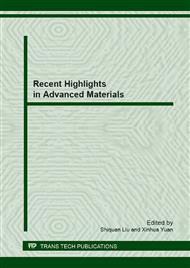p.390
p.394
p.398
p.402
p.406
p.410
p.414
p.418
p.423
Dislocation Character and Evolution Mechanism of Particles Reinforced Aluminum Matrix Composites Impacted by Pulsed Electromagnetic Field
Abstract:
Under the condition of different magnetic induced intensity as1.5T, 2.0T and2.5T, AlTiZr particles reinforced 7055 aluminum matrix composites were subject to the magnetic impact processing. The structural evolution was observed by transmission electron microscope. The result shows that, magnetic impact processing can induce dislocation with different morphologies and increase the dislocation density. The enhancement of dislocation density and elastic interaction between them can cause the resistance of dislocation movement and improve the strength of material. The magnetic pressure may exceed the yield strength of special orientation crystal. The increased temperature induced by heat effect will lower the yield point further. It is useful to dislocation nucleation and movement.
Info:
Periodical:
Pages:
406-409
Citation:
Online since:
September 2013
Authors:
Price:
Сopyright:
© 2014 Trans Tech Publications Ltd. All Rights Reserved
Share:
Citation:


